Wine and Tuscany are the perfect couple, in so far as wine making in Tuscany has always been a skill, a vocation, given the attention, love and passion with which farmers “coddle” their produce. That is why Tuscany is the quintessential wine country: the quality of its wines are not only appreciated by wine drinkers but recognized by the awarding of quality assurance labels that guarantee both the quality and the geographical area where the vines are grown, like DOC (Controlled Designation of Origin) and DOCG (Controlled Designation of Origin Guaranteed).
In recent years, signposted itineraries take you from vineyard to vineyard, wine routes or trails, “Strade del Vino” in Italian, an excellent means of getting to know wines and other typical Tuscan products better. These trails are also a means of getting to know winegrowing areas, as well as vineyards and wineries, setting wine production in a cultural, environmental, historical and social context.
The Chianti area, extending roughly over the two main city provinces of Florence and Siena, is characterized by a combination of almost perfect weather and soil that produces a precious wine considered one of the best wines around the world.
Chianti, the Chianti region (or Chiantishire, its informal nickname for years considering the number of English visitors and residents, made famous by Tony Blair in primis) offers a unique landscape, with green, gentle hills covered with wide fields of vineyards and olive groves, small stone villages, characteristic parishes and countryside homes in stone. The Chianti landscape is so beautiful and different that photographs have become postcards and calendars distributed across the globe.
Chianti wine is among the most loved (and best known) Tuscan products in the world. The title and label of Chianti wine changes, depending on the exact winegrowing area, like Chianti Classico Gallo Nero (one of the better known and protected by Chianti Classico Wine Consortium), Chianti of the Colli Aretini, Chianti of the Colli Fiorentini, Chianti of the Colline Pisane, Chianti Montalbano, Chianti Montespertoli, Chianti Rùfina and Pomino, Chianti of the Colli Senesi.
http://www.consorziovinochianti.it/
http://www.chianticlassico.com/
San Casciano Val di Pesa – 54 km (54 min)
The rural territory around the Wine and Oil Route of Lucca, Montecarlo and Versilia is unique in Tuscany for the captivating, penetrating beauty of the natural landscape and the richness of light and colour: from the white marble-topped mountains of the Apuan Alps that form a backdrop to the blue seas of the Versilia coast the historical centres of Seravezza, Pietrasanta, Camaiore and Massarosa to the rolling, light-filled hills of Lucca, city steeped in history and art before moving on to historic villas in the borough of Capannori, the fortress of Montecarlo and finally the bread making town of Altopascio famous for its connection with the Knights of the Tau.
The wine produced in this area is a harmonious blend of the local autochthonous grapes and vines of French origin that improve the taste, following guidelines and an innovative approach in the science of winemaking in Tuscany.
http://www.stradavinoeoliolucca.it/
http://www.terreditoscana.regione.toscana.it/stradedelvino/ita/lucca.html
Montecarlo – 10 km (15 min)
The outstanding winegrowing expertise in the province of Massa Carrara can be seen from the awarding of two DOC: “Candia dei Colli Apuani” from the hills of Massa Carrara and Montignoso and “Colli di Luni”, from the hills of Fosdinovo, Podenzana, Caprigliola and IGT “Val di Magra”, in fact this trail, the Wine Route of Colli di Candia and Lunigiana, encapsulates the whole province.
Tuscan culinary traditions mingle with those of Liguria and Emilia in this area, which borders on three regions. There are as many variations as there are villages in the Lunigiana area, offering the traditional simple cuisine of Tuscany along with the highest quality olive oil and wine.
http://www.stradadelvinoms.it/
http://www.terreditoscana.regione.toscana.it/stradedelvino/ita/candia.html
Montignoso – 62 km (50 min)
The territorial area of the Pisan Hills is quite sizeable: remaining within the boundaries of the province of Pisa the part covered by the Pisan HillS Wine Trail (Valdera, the Era Valley) is crossed by a tributary (the Era river) of the river Arno, like the zone of San Miniato has the river Elsa. This factor is a plus for the land and the river i san important element for winegrowing here, putting these areas “in touch” with the nearby Tyrrhenian Sea,
The Wine Trail take you on a route that winds through the river valleys and in the rolling hills with towns giving a touch of history and charm as they once stood protecting the land.
http://www.stradadelvinocollinepisane.it/
http://www.terreditoscana.regione.toscana.it/stradedelvino/ita/pisane.html
Cenaia – 25 km (30 min)
The Carmignano Medici Wine Trail was born at the end of the nineties aimed at promoting the province around the city of Prato and its food and wine products. Uniting all the local wine producers it is loosely based on the model used in Burgundy.
The use of certain vines, not very common and even unknown at the time, make this wine quite different from Chianti for its particular quality. The Cabernet grape has been part of the blend for over five centuries: it would appear that the first grapevines were transplanted here at the request of Caterina de’ Medici, when she was Queen of France in the 16th century. By way of confirmation the grape was given (and still is by the older winegrowers) the name “francesca grape“, French is “francese” in Italian and was probably deliberately misspelt, so instead of French grape it became Francesca grape.
http://www.stradavinicarmignano.it/
http://www.carmignanodivino.prato.it/prodotti-tipici/la-strada-medicea-dei-vini-di-carmignano/
Carmignano – 52 km (44 min)
The role of the San Gimignano Vernaccia Consortium is to enhance the value of the appellation, to defend the Denomination of Controlled Origin (DOC) and to carry out research and development relating to the quality of the local product.
Made from a quintessential autochthonous grape, Vernaccia is one of the oldest wines in Italy, its history goes centuries back like that of the city of San Gimignano. In 1966 Vernaccia becomes a DOC wine (it can boast the title of the first wine to be awarded this seal of quality assurance), followed by a DOCG quality certificate in 1993.
http://www.terreditoscana.regione.toscana.it/stradedelvino/ita/sgimi.html
San Gimignano – 65 km (1 h 15 min)
The Vino Nobile di Montepulciano Wine Trail Association was set up with the goal of promoting and safeguarding the image of the Montepulciano area, considering its wine-growing eminence and outstanding cultural and historical heritage.
The origins of Vino Nobile of Montepulciano are ancient and inextricably linked with the history of the town: the presence of wine cellars built as part of the old city is the most obvious sign. The wine was defined and described as “noble” in recognition of how much care and attention were paid in the production of the wine.
http://www.stradavinonobile.it/
http://www.consorziovinonobile.it/main.php
http://www.terreditoscana.regione.toscana.it/stradedelvino/ita/mpulc.html
Montepulciano – 170 km (1 h 40 min)
Amidst centuries-old olive trees and noble grapevines, the Etruscans Coast Wine Trail winds in a strip of land which runs parallel to the sea. It contains all that a visitor might wish for: medieval towns, hills covered with dense woods, views that blur the green of the vegetation with the intense blue of the sea, friendly and welcoming locals, and natural tasty food and the wines which are the fruit of the earth.
This is where the Bolgheri DOC wines originate but it is also home to Sassicaia (described in a popular magazine as “the most famous Italian wine in the world”), Ornellaia (in 1995 awarded the title Best Italian Cabernet by the magazine Decanter) and Guado al Tasso (which immediately found a place among the top wines of the country), in addition to several other wines.
http://www.lastradadelvino.com/it/Default.aspx
http://www.terreditoscana.regione.toscana.it/stradedelvino/ita/etrusc2.html
Bolgheri – 84 km (1 h 08 min)
La Strada del Vino Monteregio di Massa Marittima è un percorso nel cuore dei poderi, delle vigne e degli olivi secolari della Maremma. Il territorio del Monteregio comprende l’area delle Colline Metallifere dell’Alta Maremma Grossetana. Oltre al patrimonio enologico e gastronomico, il territorio ospita uno straordinario ambiente naturale: qui, fra incontaminati paesaggi aspri e selvaggi, si trovano infatti centri ricchi di storia e di cultura, romantici borghi ed imponenti castelli. Il vino prodotto in questo territorio, affermatosi con il nome di Monteregio, è stato riconosciuto dal marchio DOC nel 1994 e viene prodotto sia rosso che bianco. http://www.stradavino.it/ http://www.terreditoscana.regione.toscana.it/stradedelvino/ita/mmarit.html Massa Marittima – 135 km (1 h 35 min)
The Wine Route in the Maremma hills represents the essence and the heart of Maremma: it passes through the 13 boroughs in the province of Grosseto (it’s one of the longest wine trails in Italy) in a county steeped in history and traditions with ever changing landscapes (from the sea to the hills as far as Monte Amiata).
The pride and joy of this area are its 6 DOC wines, from the renowned Morellino from Scansano to Pitigliano White, from Parrina to Sovana, from Ansonica Costa dell’Argentario to Capalbio.
http://www.stradavinimaremma.it/
http://www.terreditoscana.regione.toscana.it/stradedelvino/ita/maremma.html
Scansano – 190 km (2 h 15 min)
The production zone for Montalcino wines is limited to within the boundary of the borough and is a delicacy for few, but only in the second half of the nineteenth century did it become a symbol of Made in Italy in the world.
In 1966 the Brunello di Montalcino became a DOC wine and in 1980 was the first wine to be certified DOCG, since then all its bottles are sealed with a State seal which guarantees its origin and is subject to rigorous tests. Montalcino was a forerunner in tourism lined to Italian wine with the first cellars prepared for guided tours and in the whole area that every year hosts thousands of visitors from every corner of the globe.
Widespread praise and appreciation adequately substantiate the wine’s claim to quality: in 1999 the prestigious American magazine “Wine Spectator” places Brunello among the 12 best wines of the twentieth century and in 2006 crowns Brunello putting it in first place in the world.
http://www.consorziobrunellodimontalcino.it/
Montalcino – 165 km (2 h 04 min)


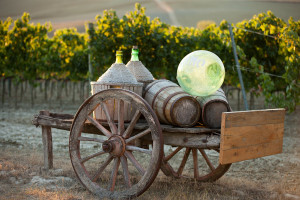
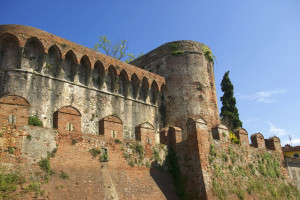
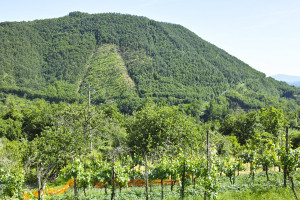
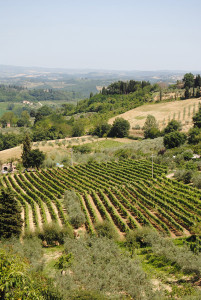
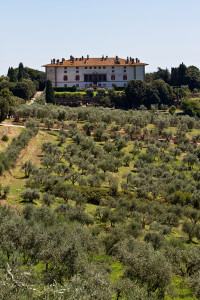
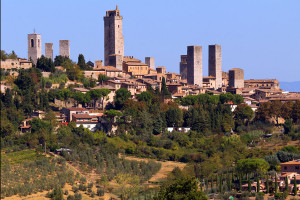
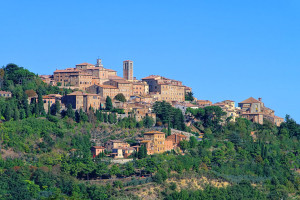
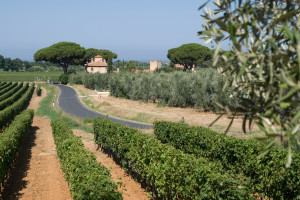
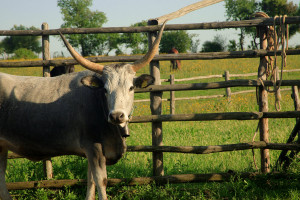
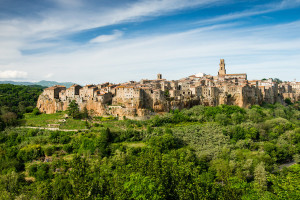
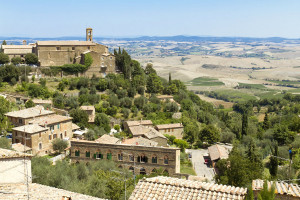
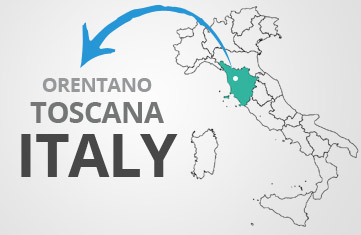 Villa Colombai
Villa Colombai